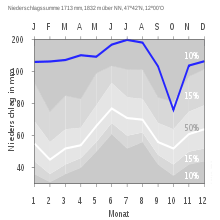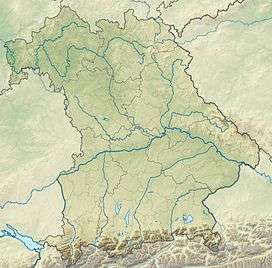Wendelstein (mountain)
| Wendelstein | |
|---|---|
|
The Wendelstein (l) from the north. To its right is the Breitenstein. | |
| Highest point | |
| Elevation | 1,838 m (6,030 ft) |
| Prominence | 740 metres (2,430 ft) |
| Coordinates | 47°42′10″N 12°00′44″E / 47.70278°N 12.01222°ECoordinates: 47°42′10″N 12°00′44″E / 47.70278°N 12.01222°E |
| Geography | |
| Parent range | Mangfall Mountains, Bavarian Pre-Alps |
| Geology | |
| Age of rock | Triassic |
| Mountain type | Wetterstein limestone |
| Climbing | |
| First ascent | unknown |
| Access | |
The Wendelstein is a 1,838-metre (6,030-foot) high mountain in the Bavarian Alps in South Germany. It belongs to the so-called Mangfall Mountains, the eastern part of the Bavarian Pre-Alps. It is the highest peak in the Wendelstein massif. Due to its exposed location it has a very good view over the Bavarian Alpine Foreland and is unmistakable for miles around. It lies between the valleys of the Leitzach and Inn and is accessible via the Wendelstein Cable Car and the Wendelstein Rack Railway. On its northern foothills rises the Jenbach, which becomes the Kalten on its way to the River Mangfall.
Local valley settlements include Bayrischzell, Brannenburg (rack railway) and Osterhofen (cable car).
Geography
Geology
The mountain consists mainly of Wetterstein limestone from the Upper Triassic with dasycladales - marine algae whose natural habitat is shallow lagoons in tropical climates.[1] The colour of the rock varies between grey white and light grey to speckled.
 The Wendelstein seen from the west
The Wendelstein seen from the west The Wendelstein from the south
The Wendelstein from the south Wendelstein's BR transmission mast
Wendelstein's BR transmission mast View from Bayrischzell of the summit
View from Bayrischzell of the summit
Climate

The annual precipitation is 1,714 mm (67.5 in) which is extremely high, lying in the upper twentieth of values in Germany. 99% of German Met Office weather stations register lower values. The driest month is October, the wettest is July, which experiences 2.6 times as much precipitation as October. Annual variations are extremely large. Only 3% of weather stations register higher annual variations.
| Climate data for Wendelstein Mountain | |||||||||||||
|---|---|---|---|---|---|---|---|---|---|---|---|---|---|
| Month | Jan | Feb | Mar | Apr | May | Jun | Jul | Aug | Sep | Oct | Nov | Dec | Year |
| Record high °C (°F) | 18 (64) |
20 (68) |
23 (73) |
29 (84) |
35 (95) |
35 (95) |
36 (97) |
37 (99) |
31 (88) |
26 (79) |
23 (73) |
19 (66) |
37 (99) |
| Average high °C (°F) | 3 (37) |
5 (41) |
10 (50) |
15 (59) |
20 (68) |
23 (73) |
24 (75) |
24 (75) |
19 (66) |
15 (59) |
7 (45) |
3 (37) |
14 (57.1) |
| Average low °C (°F) | −4 (25) |
−3 (27) |
1 (34) |
4 (39) |
8 (46) |
12 (54) |
13 (55) |
13 (55) |
10 (50) |
6 (43) |
1 (34) |
−3 (27) |
4.8 (40.8) |
| Record low °C (°F) | −19 (−2) |
−16 (3) |
−17 (1) |
−7 (19) |
0 (32) |
4 (39) |
−2 (28) |
4 (39) |
1 (34) |
−6 (21) |
−20 (−4) |
−19 (−2) |
−20 (−4) |
| Average precipitation mm (inches) | 59 (2.32) |
87 (3.43) |
103 (4.06) |
100 (3.94) |
121 (4.76) |
151 (5.94) |
166 (6.54) |
151 (5.94) |
122 (4.8) |
80 (3.15) |
95 (3.74) |
77 (3.03) |
1,312 (51.65) |
| Average rainy days | 8 | 8 | 12 | 14 | 14 | 16 | 15 | 13 | 13 | 12 | 10 | 9 | 144 |
| Average snowy days | 4 | 5 | 4 | 2 | 0 | 0 | 0 | 0 | 0 | 0 | 3 | 6 | 24 |
| Source: [2] | |||||||||||||
Development
On the summit of the mountain is the Wendelstein Chapel, an observatory, a weather station, a geopark and a transmission mast for the Bayerischer Rundfunk that can be seen from a long way off. About one hundred metres below the summit, on the ridge between the Wendelstein and the Schwaigerwand, lie the mountain inn, the termini of the rack railway and cable car, the service building for the mast, the former mountain hotel (above the station), a hut for the mountain rescue service and the well-known Wendelstein Church.
The buildings around the mountain stations are linked to the summit, 100 m (328 ft) higher, by a metalled track, which also enables the summit to be reached by inexperienced hikers over many steps and bends. Because the path cannot be used in winter, there is also a lift in the middle of the mountain for employees of the observatory, weather service and transmission site, accessed from the station of the rack railway through a tunnel.
The rack railway, built in 1912 by Otto von Steinbeis, is the oldest working rack railway in Germany. Since its renovation in the early 1990s, it has been worked by modern railcars that have reduced journey times from over 50 minutes to about half an hour.
Near the rack railway mountain station is the well-developed Wendelstein Cave with several stalactites and stalagmites, and which contain ice until well into the summer months.
The beautiful panoramic view from the summit and its easy access over the rack railway and cable car have made the Wendelstein one of the best known and most popular mountains in the Bavarian Alps.
Wendelstein Church
The foundation stone of the Wendelstein Church (Wendelsteinkircherl) was laid on 1 July 1889 on a rocky ridge a hundred metres below the summit. On 20 August 1890 Germany's highest church was consecrated. It is dedicated to the Patrona Bavariae and is managed by the Archdiocese of Munich and Freising as a satellite church of the parish of Maria Himmelfahrt in Brannenburg. The Wendelstein Church's description as the "highest church in Germany" is indisputable;[3][4] all other higher church buildings (such as the Zugspitze Chapel consecrated in 1981) are not churches in the ecclesiastical sense, but only chapels. Regular masses and marriage services take place in the mountain church in summer.
The little Wendelstein Church is also often called a chapel or the Wendelstein Chapel, but that is not only wrong from an ecclesiastical point of view, but also because there is actually a separate Wendelstein Chapel. This is dedicated to St. Wendelin and stands just below the summit. This summit chapel, a small wooden affair, is considerably older than the church; there are reports of it going back to the early 19th century.
 The Wendelstein Church
The Wendelstein Church- Interior
Mountain weather station and observatory
On the summit of the Wendelstein there is a weather station belonging to the German Meteorological Office, which is manned around the clock, and an observatory of the Institute for Astronomy and Astrophysics at the Ludwig Maximilian University, Munich. With an average of over 120 clear nights per year, Wendelstein's location is ideal for such installations.
The first weather observations on the Wendelstein were recorded in a makeshift observatory erected by the summit chapel by Paul Schiegg in July 1804, the records were, however, often frustrated by lightning, storms, snow and rain. In 1883 the Wendelsteinhaus Meteorological Station was built by Dr. Fritz Erk of the Royal Bavarian Meteorological Central Station in Munich at an altitude of 1700 m. This was the first Alpine station in the Royal Bavarian Meteorological Station Network. The delivery of mail to and from this station was carried out in winter by the members of the Wendelsteinhaus Alpine Club and in summer by tourists. In 1962, the present weather station was built at the summit. It is staffed around the clock with full-time staff.
The observatory was founded in December 1939 by Karl-Otto Kiepenheuer as a solar observatory for the Luftwaffe. The recording of solar activity was supposed to enable the most accurate forecast possible of the optimal frequencies used for military communications. After the Second World War the observatory was funded by the US forces for the same purpose. Since 1949 the facility has belonged to the University of Munich. In the 1960s the observatory was enhanced with a coronagraph; a device that enabled research to be carried out on the atmosphere of the sun. Due to increasing air pollution and research priorities switching back to night-time astronomy, scientific observations of the sun were ceased in the 1980s. Since 1988 the facility has become purely an observatory; the dome of the coronograph is only used today for viewing purposes. Today searches are conducted from the Wendelstein for extrasolar planets by evaluating occultations and research is carried out on variable stars in dwarf galaxies using an 80-cm telescope and CCD cameras. In 2011 the 80-cm telescope will be replaced by an instrument with a two metre aperture.[5]
In addition, from 1950 to 1960 there was an observatory on the eastern summit of the Wendelstein, consisting of an observation dome and a residential house. There, the astronomer Rudolf Kühn carried out research. The facility was completely demolished in 1965, only the remains of the foundations are still visible. Where the observation dome once stood, a wind turbine was later built, but that, too, was dismantled in 2007.
Ski area
The rack railway and gondola lift and two drag lifts serve a small but challenging ski area on the Wendelstein. Plans to link it to the Sudelfeld ski area were discarded. Because of a dispute with an alpine farmer, there was no skiing on the Wendelstein from 1995 to 1997.
In spite of numerous explosions and other construction projects in the past 40 years, most of the runs on the Wendelstein are steep rugged slopes that are only suitable for experienced skiers. The most important and most feared downhill run is the Ostabfahrt that runs from the terminus of the Lacher lift to the Mitteralm. 3.8 km in length, it descends 500 m in altitude. Similarly difficult, albeit only a few hundred metres long, is the so-called Hotelhang, which runs from the termini of the railway and gondola lift to the main ski area and must be negotiated by every skier, even if they want to ski the easy runs around the Wendelstein's mountain pastures or Wendelsteinalmen. The Lacherlift to the Ostabfahrt begins in these pastures. The run from the Hotelhang to the Wendelsteinalmen goes past the so-called Krematorium, a rock face exposed in fine weather directly to the sun. The place was therefore used by skiers for sunbathing and tanning used - "to burn their bodies", hence the macabre name. Further on, there are two options: a steep slope and the somewhat easier variation via Davos - or in the local dialect "da wo's" ("there, where it is").
Throughout the year members of the Brannenburg Mountain Rescue Service are on duty at the so-called Klausen Hut (opposite the Wendelstein Church) and in the ski area and aim to reach ill or injured climbers as quickly as possible. There is even a defibrillator on the Wendelstein at all times.
External links
References
- ↑ Geologische Karte von Bayern mit Erläuterungen (1:500.000). Bayerisches Geologisches Landesamt, 1998.
- ↑ "Yearly Trends: Weather Averages and Extremes for Wendelstein Mountain". Weather2.com. Retrieved April 15, 2012.
- ↑ Mit der Zahnradbahn auf den Wendelstein at www.suite101.de. Accessed on 19 Mar 11.
- ↑ Hinauf zur höchst gelegenen Kirche Deutschlands at www.militaerseelsorge.bundeswehr.de. Accessed on 19 Mar 11.
- ↑ Universitäts-Sternwarte München: Geschichte

